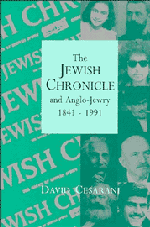Book contents
- Frontmatter
- Contents
- Preface
- Acknowledgements
- Introduction
- 1 Origins and pioneers, 1841–1855
- 2 Defining an identity: the Jewish Chronicle and mid-Victorian Anglo-Jewry, 1855–1878
- 3 The era of Asher Myers and Israel Davis, 1878–1906
- 4 The hegemony of Leopold Greenberg, 1907–1931
- 5 Discordant interlude: J. M. Rich and Mortimer Epstein, 1932–1936
- 6 Ivan Greenberg and the crisis years, 1937–1946
- 7 The post-war era: J. M. Shaftesley and David Kessler, 1946–1958
- 8 The Jewish Chronicle under William Frankel, 1958–1977
- 9 The Jewish press in a divided community: Geoffrey Paul, 1977–1990
- Conclusion
- Notes
- Bibliography
- Index
- Plate section
6 - Ivan Greenberg and the crisis years, 1937–1946
Published online by Cambridge University Press: 22 September 2009
- Frontmatter
- Contents
- Preface
- Acknowledgements
- Introduction
- 1 Origins and pioneers, 1841–1855
- 2 Defining an identity: the Jewish Chronicle and mid-Victorian Anglo-Jewry, 1855–1878
- 3 The era of Asher Myers and Israel Davis, 1878–1906
- 4 The hegemony of Leopold Greenberg, 1907–1931
- 5 Discordant interlude: J. M. Rich and Mortimer Epstein, 1932–1936
- 6 Ivan Greenberg and the crisis years, 1937–1946
- 7 The post-war era: J. M. Shaftesley and David Kessler, 1946–1958
- 8 The Jewish Chronicle under William Frankel, 1958–1977
- 9 The Jewish press in a divided community: Geoffrey Paul, 1977–1990
- Conclusion
- Notes
- Bibliography
- Index
- Plate section
Summary
The deluge begins, 1937–1939
Following his father's death Ivan Greenberg (1896–1966) had always felt that the editorship of the Jewish Chronicle was rightfully his. The boardroom upheaval during 1935 ultimately cleared the way for his appointment. The youngest son of Leopold Greenberg and his first wife, Marion Gates, Ivan was born and educated in London. During the First World War he served in the Royal Field Artillery and was wounded in action on the Western Front. After demobilisation he travelled widely as a journalist, working on newspapers in South Africa and Australasia. He joined the Jewish Chronicle staff as assistant editor in 1925. When he became editor, he was succeeded in his former post by John M. Shaftesley (1901–81), a Lancashire-born journalist who had worked for the Manchester Guardian and served as Manchester correspondent for the Jewish Chronicle before moving to the London office. Simon Gilbert continued as associate editor, writing the leading articles and ‘In the Communal Armchair’.
The business side of the paper was now in the hands of Alfred Brown Guthrie (1874–1959), a Scot, and David Kessler. Guthrie had transferred to the Jewish Chronicle from Greenberg's advertising agency and became successively advertising manager and general manager. Good humoured, hard working and wholly devoted to the welfare of the paper, he held this post until 1955. David Kessler was born in Pretoria in 1906, while his father was in South Africa working as a consulting mining engineer.
- Type
- Chapter
- Information
- The Jewish Chronicle and Anglo-Jewry, 1841–1991 , pp. 158 - 192Publisher: Cambridge University PressPrint publication year: 1994



